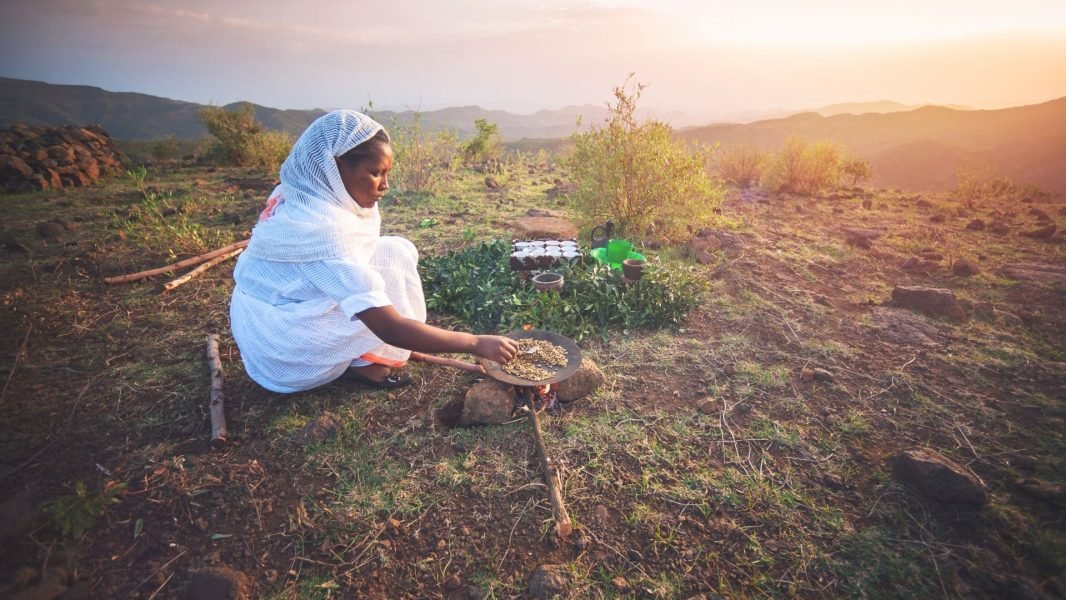Have you ever taken that first sip of coffee in the morning and wondered—where coffee originated? How did this rich, energizing beverage go from mysterious red berries in the mountains to the heart of your daily ritual?
It all began with goats. Seriously.
Long before coffee shops lined every street and baristas perfected your oat milk latte, a goat herder in Ethiopia noticed something strange—his goats were dancing. That moment sparked a journey that would brew into centuries of trade, tradition, and taste. Today, understanding where coffee originated gives us more than trivia—it connects us to a deep, global heritage.
Let’s explore the true origin of coffee, how it spread across the world, and why this knowledge still matters today.
Where Coffee Originated: The Story Starts in Ethiopia
Our story begins in 9th-century Ethiopia, widely considered the land where coffee originated. A herder named Kaldi noticed his goats were unusually energetic after nibbling red berries from a wild bush. Curious, Kaldi tried the berries himself—and soon, he too felt an incredible surge of energy.
He brought the berries to a nearby monastery. One version of the legend says the monks brewed a drink and found it helped them stay awake during evening prayers. Another version says they threw the berries into the fire, where the roasted seeds released a divine aroma—marking the world’s first roasted coffee.

Regardless of the version, Ethiopia became the epicenter of a global phenomenon. The beans that helped monks pray through the night would one day help millions power through their 9 a.m. meetings.
From Ethiopia to Yemen: The Spiritual Spread of Coffee
By the 15th century, coffee had crossed the Red Sea into Yemen, where Sufi mystics used it to stay alert during long meditative sessions. Yemen became a powerhouse of early coffee culture—especially the port of Mocha, a name that still graces café menus today.

Coffee was prepared in homes and served in qahveh khaneh, early coffeehouses where people gathered to listen to music, play chess, and discuss politics. This was more than a beverage; it was a social movement.
If you’re curious about how industrialization later shaped coffee production, check out this article on industrial coffee plants.
Smuggled Beans and the Rise of Coffee in Asia
Coffee was so prized in Yemen that exporting fertile beans was banned. That is, until one bold traveler—Baba Budan—smuggled seven raw coffee beans hidden in his beard from Yemen to India. There, the first Asian coffee farms took root.

Coffee eventually reached Indonesia in the 17th century via Dutch traders. The island of Java became one of the first large-scale coffee-growing regions outside Arabia.
Indonesian coffee is still highly respected today. Sumatra offers earthy, full-bodied profiles, while Aceh Gayo beans are known for their balance and sweetness. Curious about underrated gems? Explore Lampung coffee for a bold, peppery surprise.
Want your beans to last longer? Here’s how to store coffee beans the right way.
Where Coffee Originated in European Culture
So, where did coffee originated in Europe? The answer: Venice, around 1570. Brought in by traders from the East, coffee rapidly spread through Italy, France, Austria, and England.
- In England, “penny universities” (coffeehouses) allowed everyday citizens to exchange ideas over a single cup.
- In Austria, after the failed Turkish siege of Vienna in 1683, abandoned sacks of beans led to the opening of the famous Blue Bottle café.
- In France, coffee was introduced by the Turkish ambassador and quickly became fashionable in the court of Louis XIV.
Coffeehouses became intellectual centers, birthing revolutions, literature, and movements. Coffee wasn’t just a drink—it fueled enlightenment.
How Coffee Reached the Americas and Grew an Empire
By the 18th century, coffee was spreading to the Americas. A French naval officer named Gabriel de Clieu brought seedlings to Martinique, sparking plantations across the Caribbean.
But the real turning point came in Brazil. In 1727, Colonel Francisco de Melo Palheta charmed the wife of the French Guianan governor to smuggle out coffee seeds. He planted them in Brazil—and the country’s coffee boom began.

By the mid-1800s, Brazil had become the world’s largest producer, a title it still holds today.
Why Knowing Where Coffee Originated Still Matters
Knowing where coffee originated helps you appreciate each cup with greater depth. It turns a routine habit into a shared human story—one that spans continents, climates, and cultures.
In the age of specialty coffee processing, origin is everything. The soil, altitude, and local farming methods all affect the final taste. That’s why today’s coffee lovers seek transparency—wanting to know where their beans come from and how they’re grown.
By tracing coffee back to its roots, we connect with farmers, traditions, and the science behind every sip.
Final Thoughts: Your Coffee Has a Story—Do You Know It?
The next time you sip your morning brew, take a second to think: Where did my coffee originate? Was it grown on a misty mountain in Ethiopia or a volcanic slope in Sumatra? Did it pass through centuries of history before landing in your mug?
Understanding where coffee originated makes every cup feel more meaningful. It’s not just a caffeine fix—it’s a celebration of nature, resilience, and global connection.
Ready to elevate your coffee game? Start by discovering how to find the best specialty bean suppliers.

